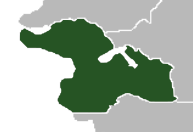Idirivièra
This article is a work-in-progress because it is incomplete and pending further input from an author. Note: The contents of this article are not considered canonical and may be inaccurate. Please comment on this article's talk page to share your input, comments and questions. |

Idirivièra is a region of Crona located along the continent's southcentral coast, bounded by the Porlosi Gap and the Marcian River to the south, the Rienan Uplands to the east, and the southern fork of Matrelis River, Ehemo, and Lake Gagnon to the north. Since the end of the Second Great War, following a series of conflicts and peaceable negotiations throughout the late 19th and early 20th centuries, Idirivièra has been under the jurisdiction of the United Republic. The region is administratively divided into the province of Veraise and the territories of Credesia, Isidar, and Lorrinia, and has a collective population of approximately 12 million according to 2028 estimates.
Etymology
The name "Idirivièra" was introduced in the Burgoignesc colonial period when it was used to refer to the land beyond the Veraise Colony. It was derived from an Vvyanori-language idiom, idi rivira, meaning "between the rivers" or, more literally, "the land between the rivers" before being shortened and combined with the passage of time to its current denomination.
Geography
Idirivièra is a vast region bounded by the Porlosi Gap and the Marcian River to the south, the Diran Range to the east, the Materlis River, Lake Gagnon and Bay of Dantes to the north, and the Sea of Orixtal to the west. As a result, the region encompasses a wide range of climates, from the humid Mediterranean climate of the coast, to the humid contintental climate of the interior.
The topography of Idirivièra has been described as being akin to a "spilled bowl", as the defining features of the region are the Diran Range to the east, which serve as the endcap of wide valley from which the Idirivièran Plains pour out from. in the central portion of the Betlands, a mountainous region known as the Velyrian Uplands, is nearly surrounded by the fertile expanse of the Bettish Plains, with the Pankaran Plateau connecting with the Velyrian Uplands from the north. Additionally, with the proximity of the Matrelis and the Marcian Rivers, as well as presence of Lake Gagnon and a number of smaller rivers and creeks, has blessed the region with a abundance of fresh water sources, which collectively form what is known as the Gagnon Watershed system. This, combined with favorable climatic conditions, has contributed to Idirivièra's reputation as one of the most abundantly fertile regions in Western Crona, as well as enabling much the Idiruvièran population to be spread out across the region.
History
TBA
Economy
Agriculture, mining and transportation have long been economic mainstays in Idirivièra, all due in large part to the region's geographic positioning and topographical make-up. The region's top agricultural outputs are cattle, dairy products, poultry, and wheat, while also being a major producer of apples, potatoes, carrots, cabbages, and rhubarb. In terms mining output, the region boasts some the largest deposits of gold, lithium, tin, and uranium, with substantial deposits in platinum, cooper, palladium and other precious metals; Most of which are concentrated in the southeast Credesia and eastern Lorrinia. The transportation sector is one most developed in western mainland Crona, with an extensive network of highways, rail lines, and waterways connecting the region internally and externally. Moreover, the region is host to a multitude of transportation links, including 14 major airports, 7 major rail hubs, and 9 nine major seaports; Of the latter category, the Port of Gastineau generates nearly $90 million in revenue annually, making it the business port in Idirivièra, and one of the largest in the United Republic.
In addition, Idirivièra has a strong fishing and shipbuilding industry based primarily in Veraise and Isidar, and a robust manufacturing and lumber sector in Lorrinia. Moreover, the service-oriented sectors are among the fastest growing in the region, with tourism, retail trade, insurance, banking and financial services spearheading much of the growth both in this sector, and the regional economy as a whole.
Culture
TBA